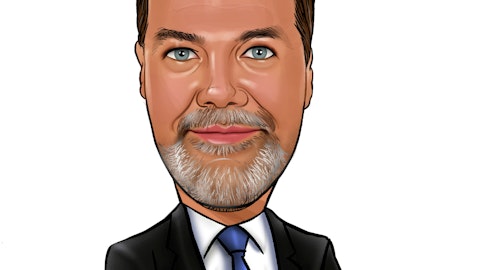John Jackson: I wouldn’t say it’s a structural change in allocation of capital other than one, we do have some debt maturities coming up, so that’s something to take a look at. But we also have to look at where everything trades and what the best return is. And at the moment, just based on rising interest rate environment that we’ve been in, our bonds trade off relative to where they were trading a year ago. And so we committed all of our capital a year ago into this year primarily. We have a little bit of free cash flow left this year and then we go into next year, we’ve under committed a little bit of our capital for next year, but mostly committed. So now as we think about that delta wedge of what’s left to commit right now, it’s a much more attractive return to either build liquidity, but more importantly, buy bonds off the market if available, at a 15% to 25% to 35% rig return.
So looking at — if you can get a 25% or 35% rate of return, I think we’re going to take a hard look at that relative to building a new unit. So it’s really capital efficiency.
Jeff Grampp: Absolutely. That makes a lot of sense. I appreciate the time guys.
Operator: Our next question comes from Selman Akyol from Stifel. Please go ahead.
Selman Akyol: Thank you. So just wanted to step back for a moment and going back to sort of the index to inflation. And I heard you say 50% of your multiyear fleet is under CPI. I guess how much of your fleet is then one year or less should we be thinking about?
John Jackson: How much of our fleet is — has term of one year less?
Selman Akyol: Correct.
John Jackson: Right now, we have about — it’s about probably 60%-40%, 60% — we have probably 40% — a little over 40% of our fleet has over one year left on its term on a revenue basis, revenue dollar basis. But if you look at that in the context of — on a spot basis, how much has turned left, over 70% of our fleet revenue-wise is under term but only 40% of its over one year. So we’ve got a lot to tackle over the course of the coming 12 months is what I’m getting to.
Selman Akyol: Got it. Got it. And then just to be clear when you talk about your fleet, are you talking about it in terms of horsepower or units?
John Jackson: I’m talking about this in the terms of horsepower. Units would be wildly different because we have so many gas jacks that are small.
Selman Akyol: Got it. So nice improvement on the gross margin and I’m wondering, is there much more to go there?
John Jackson: Well, we think we’ll continue to see repricing of our fleet to market. So there’s a little bit variable yet. And as I kind of alluded to in the comments, that the operational execution is really where we’ve been spending time over the last — not that we haven’t been focused on that, but it’s been a very, very busy year and half, putting a lot of equipment out, building a lot of new equipment, electrifying units, just turnover high levels of terminal coming out of COVID, retraining new people. So all that is all very interesting, but we’ve now been able to over the last four or five months really focus in on planning and executing our day-to-day work. And that has begun to reap some dividends, but I don’t think we’re there yet as far as what I’d say is smooth, monthly execution all the way across the board.

